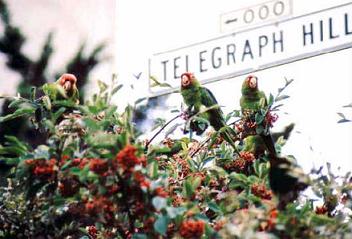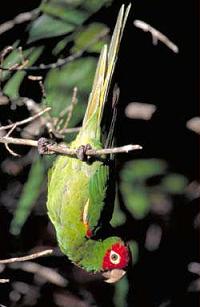The Wild Parrots of Telegraph Hill


A little into The Wild Parrots of Telegraph Hill, Mark Bittner worries that people may label him an eccentric. After all, he looks like an aging hippie, and spends him time tending to a flock of cherry-headed conures, native to South America. Well, sorry to inform Mr. Bittner otherwise, but he most definitely is an eccentric. But there is absolutely nothing wrong with that, especially since Bittner is such an engaging personality, with so much love and devotion towards these animals. Wild Parrots is a surprisingly absorbing documentary, because of both Bittner and the emotional investment that director Judy Irving (Kids by the Bay) place in the film.
Nobody is sure where the flock came from. Many theories abound, but the likeliest one is that a few were escaped pets, and began to breed. The conures thrived in the San Francisco environment, and became an attraction unto themselves. Bittner noticed them, and began meticulously studying them. He spent a lot of time around them, so they began to feel comfortable in his presence. In all, Bittner spent about five years around these conures, enough to name them and form a deep bond with the entire flock. Bittner himself has a genial presence, which is extremely beneficial for the film. He comes across as a very nice guy who genuinely cares for these birds. His love of the birds is infectious, and causes the viewer to feel the same way. It's never clear how he earns a living; he lives rent free in a cottage, and is evasive when Irving asks what he does for a living.
Irving spent a lot of time filming (which reaped its own rewards late in the film), so she was able to pick and choose from what one assumes is a massive amount of footage. This really helps when Bittner is describing the temperaments of the different conures. While it may be one thing to anthropomorphize these birds, it's another to simply watch how they interact with each other. Through Bittner's narration and Irving's footage, one can see the different personalities emerge from the conures, and how they act towards both Bittner and each other. Bittner named many of them. Conner is the grumpy elder statesman. Sophie and Picasso are a pair, each one a bit damaged. Mingus is the only one that stays outside. All of it is undeniably cute, but also informative from a scientific perspective. Bittner is observing their behavior, and meticulously noting everything they do.
And Bittner steadfastly maintains that these birds are still wild. The fact that they feel comfortable perching on him and eating out of his hand says otherwise, but they probably inhabit a strange nether region between tame and wild. They clearly do not need Bittner to survive; there are plenty of other food sources they use, and they need to contend with their a few species of hawks. Unfortunately, circumstances force Bittner to move away from Telegraph Hill, which provides a serious injection of drama in the third act. Bittner has no idea where he is going to live, and is not sure who will take care of some of the birds that rely on him (like Mingus, who actually lives in his house). By this point, anybody watching will be caught up in all of the events. Irving doesn't do anything flashy; she just lets the images and Bittner, who speaks in a very easygoing manner, charm over the viewers.